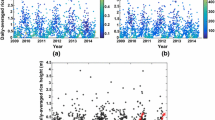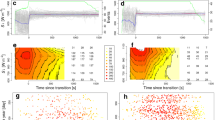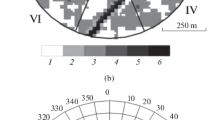Summary
A description is presented of experimental techniques used and results obtained in measuring radiation at various levels in a pine forest. When point source values of solar radiation below the canopy were compared to horizontal average values for the same hours, hourly average values were found to vary from 60% to 260%, whereas average daily values varied only as little as 2% to 11%.
The amount of solar radiation which penetrated the canopy varied both diurnally and seasonally. The greatest seasonal variation (from 44% to 33%) was observed within the span of a few weeks during the leafing season, even though there were only a few deciduous trees in the area.
A higher albedo was found for spruce than for pine, and diffuse to direct solar radiation was shown to vary with air mass. Net long-wave radiation was higher with Arctic air masses than with Maritime Polar or Tropical air masses. Atmospheric emissivity did not correlate well with either air temperature or vapour pressure when morning data were combined with afternoon data. A somewhat improved relationship was possible when morning and afternoon data were grouped separately.
Downward long-wave radiation below the canopy was controlled primarily by lower canopy temperatures and secondarily by downward long-wave sky radiation. It was estimated that after leafing only about 15% to 20% of downward long-wave sky radiation was penetrating to below the canopy.
Zusammenfassung
Es wird über die Beobachtungstechnik und die erhaltenen Resultate von Strahlungsmessungen in verschiedenen Höhen in einem Kiefernwald berichtet. Beim Vergleich von Globalstrahlungswerten an Einzelmeßstellen unter den Kronen mit durchschnittichen Werten in horizontalen Schnitten wurden Stundenmittel gefunden, die von 60% bis 260% schwanken, während die Tagesmittel nur zwischen 2 und 11% voneinander abweichen.
Der Betrag der die Baumkronen durchdringenden Globalstrahlung weist eine Tages- und eine Jahresschwankung auf. Die größte jahreszeitliche Änderung (von 44 auf 33%) wurde innerhalb von wenigen Wochen während der Laubentwicklungszeit beobachtet, obwohl nur wenige Laubbäume in dem Gebiet waren. Bei Tannen zeigt sich eine höhere Albedo als bei Kiefern. Das Verhältnis zwischen diffuser und direkter Sonnenstrahlung ändert sich mit der Luftmasse.
Die langwellige Strahlungsbilanz ist in arktischen Luftmassen größer als bei maritimen polaren oder tropischen Luftmassen. Die atmosphärische Ausstrahlungsfähigkeit ist weder mit der Lufttemperatur noch mit dem Dampfdruck gut korreliert, wenn man Vormitags- und Nachmittagsbeobachtungen zusammennahm. Eine deutlichere Beziehung wird erhalten, wenn Vormittags- und Nachmittagsbeobachtungen getrennt verwendet werden.
Die abwärts gerichtete langwellige Strahlung unter den Kronen hängt in erster Linie von der niedrigeren Kronentemperatur ab und in zweiter Linie von der langwelligen Gegenstrahlung. Es wird geschätzt, daß nach der Belaubung nur etwa 15 bis 20% der langwelligen Gegenstrahlung in den Raum unter den Kronen eindringt.
Similar content being viewed by others
References
Funk, J. P.: Improved Polythene-Shielded Net Radiometer. J. Sci. Inst.36, 267–270 (1959).
Gates, D. M.: Characteristics of Soil and Vegetative Surfaces to Reflected and Emitted Radiation. Proceedings of the Third Symposium on Remote Sensing of the Environment, Michigan University, 573–599, Feb. 1965.
Idso, S. B., andR. D. Jackson: Thermal Radiation From the Atmosphere. J. Geophys. Res.74, 5397 (1969).
McDonald, T. H.: Some Characteristics of the Eppley Pyrheliometer. Monthly Weather Review79, 153–159 (1951).
Miller, P. C.: Leaf Temperatures, Leaf Orientation and Energy Exchange in Quaking Aspen and Ambells Oak in Central Colorado. Ecol. Plant. Gauthier Villars2, 241–270 (1967).
Monteith, J. L.: The long-wave Radiation Balance of the British Isles. Quart. J. R. Met. Soc.87, 171 (1961).
Monsi, M., undT. Saeki: Über den Lichtfaktor in den Pflanzengesellschaften und seine Bedeutung für die Stoffproduktion. Japan J. Botany14, 22 (1953).
Pollard, P. F. W.: Measurement of Photosynthesis in the Canopy of a Pine Forest. Forestry Branch, Department of Fisheries and Forestry, Ottawa, Canada (1969).
Swinbank, W. C.: Long-wave Radiation From Clear Skies. Quart. J. R. Met. Soc.89, 339 (1963).
Uchijima, Z.: Studies on the Microclimate Within Plant Communities (1) On the Turbulent Transfer Coefficient Within Plant Layer. J. Agr. Meteorol. Japan18, 1–9 (in Japanese) (1962).
Author information
Authors and Affiliations
Additional information
With 12 Figures
Rights and permissions
About this article
Cite this article
Mukammal, E.I. Some aspects of radiant energy in a pine forest. Arch. Met. Geoph. Biokl. B. 19, 29–52 (1971). https://doi.org/10.1007/BF02243401
Received:
Issue Date:
DOI: https://doi.org/10.1007/BF02243401




